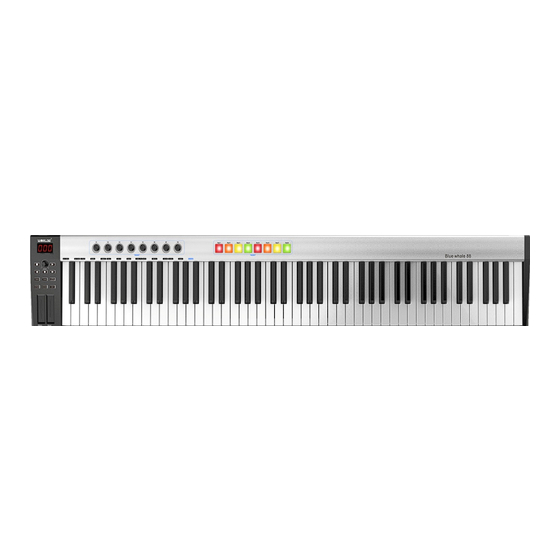
Summarization of Contents
Introduction
What's in the Box?
Lists all items included in the product packaging.
Blue Whale Keyboard Overview
Highlights the key features of the Blue Whale keyboard series.
Section 1: Getting Started
1.1 Blue Whale Keyboards Overview
Details the features and components of the Blue Whale keyboards.
1.1.1 Top Panel Overview
Describes the controls and displays on the top surface of the keyboard.
1.1.2 Side Panel Overview
Details the ports and connections found on the side of the keyboard.
1.2 Setup
Guides the user through connecting and setting up the Blue Whale keyboard.
1.2.1 Minimum System Requirements
Specifies the hardware and software requirements for using the Blue Whale with a computer.
1.3 Using The Blue Whale with Your Software
Explains how to integrate the Blue Whale controller with music software.
1.4 MIDI Connections
Details how to establish MIDI connections for audio output.
1.5 Power Supply
Explains the power requirements and options for the Blue Whale.
Section 2: Basic MIDI Control from Your Blue Whale
2.1 Function Keys/Multi-functional keyboard
Introduces the function keys and their multi-functional capabilities.
2.2 The Keyboard
Explains how the keyboard sends MIDI note messages and basic functions.
2.2.1 Velocity Curve
Details how to select and adjust velocity curves for playing dynamics.
2.2.2 OCTAVE
Explains how to adjust the keyboard's octave for pitch transposition.
2.2.3 TRANSPOSE
Explains how to adjust the keyboard's pitch up or down by semi-tone.
2.3 CHANNEL
Guides on selecting and adjusting the MIDI channel for the keyboard.
2.4 CHANGING VOICE AND VOICE BANK
Details how to change instrument voices and select voice banks.
2.5 MIDI Controller Messages
Explains MIDI controller messages for parameter control.
2.5.1 Programming the Controls on MIDI Controller
Describes the process of assigning functions to physical controllers.
2.5.2 ASSIGNABLE DIAL
Explains how to assign channels and controller numbers to the dials.
2.5.3 PITCH BEND AND MODULATION TOUCH STRIPS
Details the function of pitch bend and modulation touch strips.
2.5.4 ASSIGNABLE PEDAL
Explains how to assign controller numbers to the pedal inputs.
2.5.5 PAD SETTING
Guides on setting controller numbers for the performance pads.
Section 3: Advanced Settings
3.1 How to make good use of the keyboard
Provides tips for utilizing advanced keyboard functions.
3.1.1 DUAL
Explains the Dual function for layering sounds on two channels.
3.1.2 SPLIT
Details the Split function for dividing the keyboard into sections.
SPLIT POINT
Describes how to set the split point for keyboard sections.
3.2 Other controls
Covers additional controls and their functions.
3.2.1 MUTE
Explains how to use the Mute function to stop MIDI output.
3.2.2 CONTROL ASSIGN
Details how to assign controllers to various functions.
3.2.3 GM
Explains sending General MIDI (GM) ON messages.
3.2.4 GS
Explains sending General Standard (GS) ON messages.
3.2.5 XG
Explains sending Extended General (XG) ON messages.
3.2.6 Reset
Describes how to reset the system to factory settings.
3.2.7 SNAP SHOT
Explains how to save and send user settings.
3.2.8 PEDAL POLARITY
Details how to change the polarity of the pedals.
3.2.9 SHIFT BUTTON GROUPS(1-8/9-16)
Explains the function of shift buttons for banks.
3.3 Pad Control
Covers controlling the performance pads.
3.3.1 Pressure Control
Explains using pressure sensitivity for pad performance.
3.3.2 Pad Curve
Details how to set response curves for the pads.
3.3.3 Pads Note setting
Guides on setting MIDI notes for the pads.
3.3.4 Select the Backlit RGB Colour for the 8 Pads
Explains how to customize the RGB backlight color of the pads.
Section 4: Usage Examples
4.1 Recording Your Performance on A Sequencer
Provides guidance on recording performances using a sequencer.
Section 5: MIDI Information Specification
5.1 Program & Bank Changes Explained
Explains MIDI Program Change and Bank Change messages.
Section 6: Troubleshooting
Blue Whale suddenly stopped working
Provides steps to resolve issues when the device stops working.
Latency Issues
Explains causes of latency and how to reduce it.
Section 7: Technical Info
Cautionary Notes
Provides important cautions regarding electrical interference and modifications.
FCC Compliance
Details FCC compliance information and potential interference mitigation.
WARNING: Chemical Exposure
Informs about chemical content and associated health risks.
Section 8: Appendices
Appendix A - MIDI IMPLEMENTATION CHART
Presents a chart detailing MIDI implementation.
Appendix B - Useful MIDI Data Tables
Provides tables with useful MIDI data, including program change numbers.
Appendix C - General MIDI Controller Numbers (MIDI CC's)
Lists general MIDI controller numbers and their functions.
Appendix D – Assignable Controller Numbers to Linear Controllers
Details assignable controller numbers for linear controls.
Appendix E-Assignable Controller Numbers to Non-Linear Controllers
Details assignable controller numbers for non-linear controls.
Appendix F - Assignable Controller Numbers to Rotary Encoders
Details assignable controller numbers for rotary encoders.
Appendix G – Assignable Controller Numbers to Pressure Pads
Details assignable controller numbers for pressure pads.
Appendix H - Factory Presets
Lists factory presets for various controls.
Appendix I - Hexadecimal Conversion Chart
Provides a chart for hexadecimal to decimal conversion.

















Need help?
Do you have a question about the BLUE WHALE 37 and is the answer not in the manual?
Questions and answers